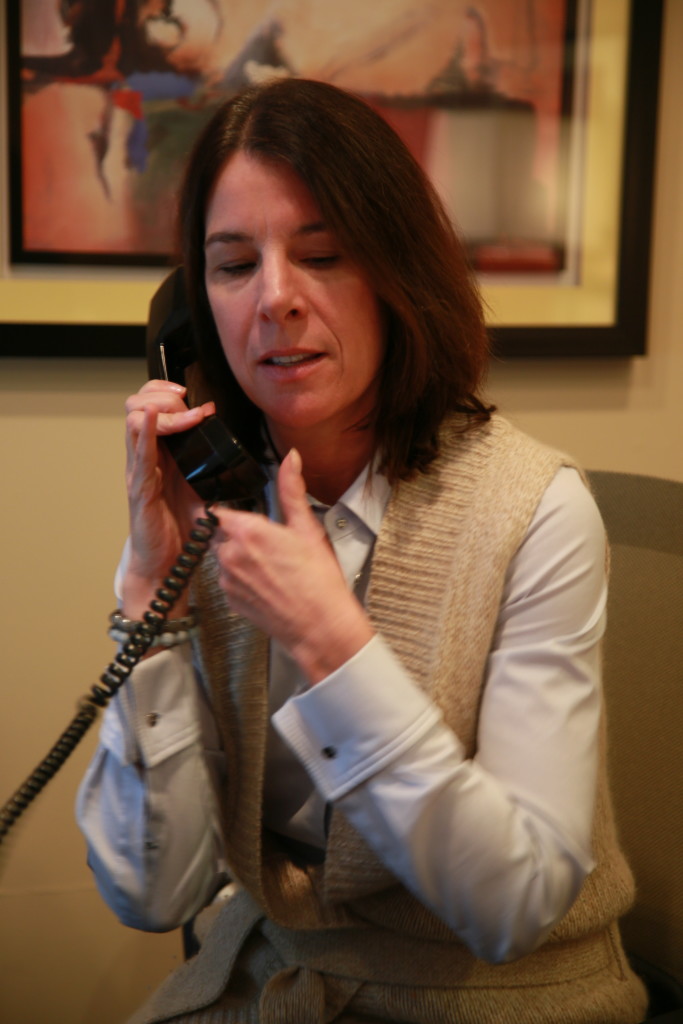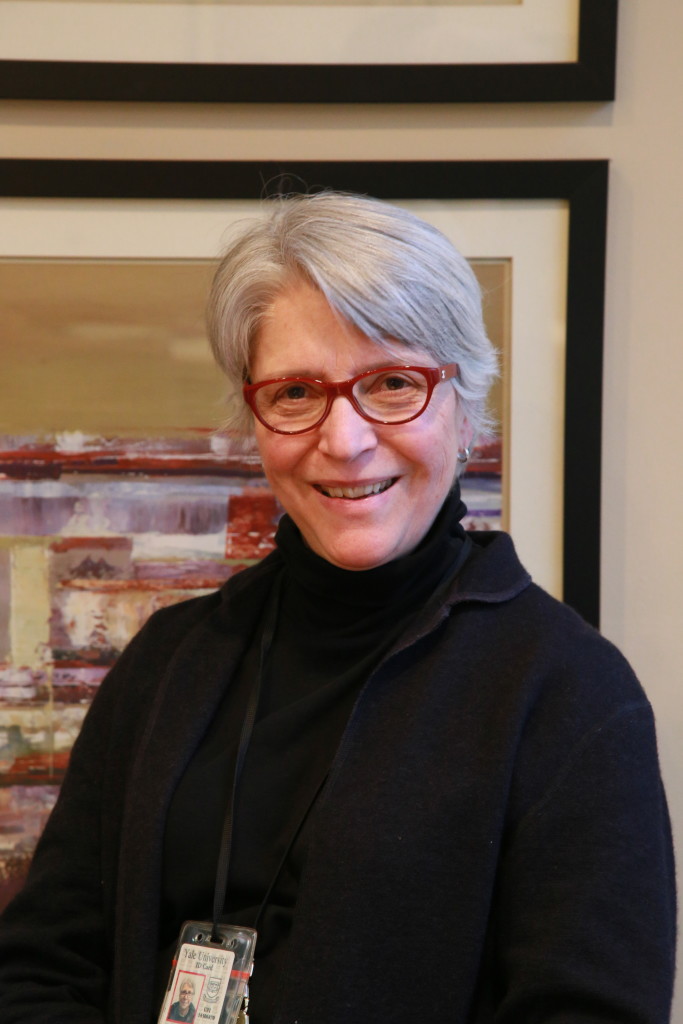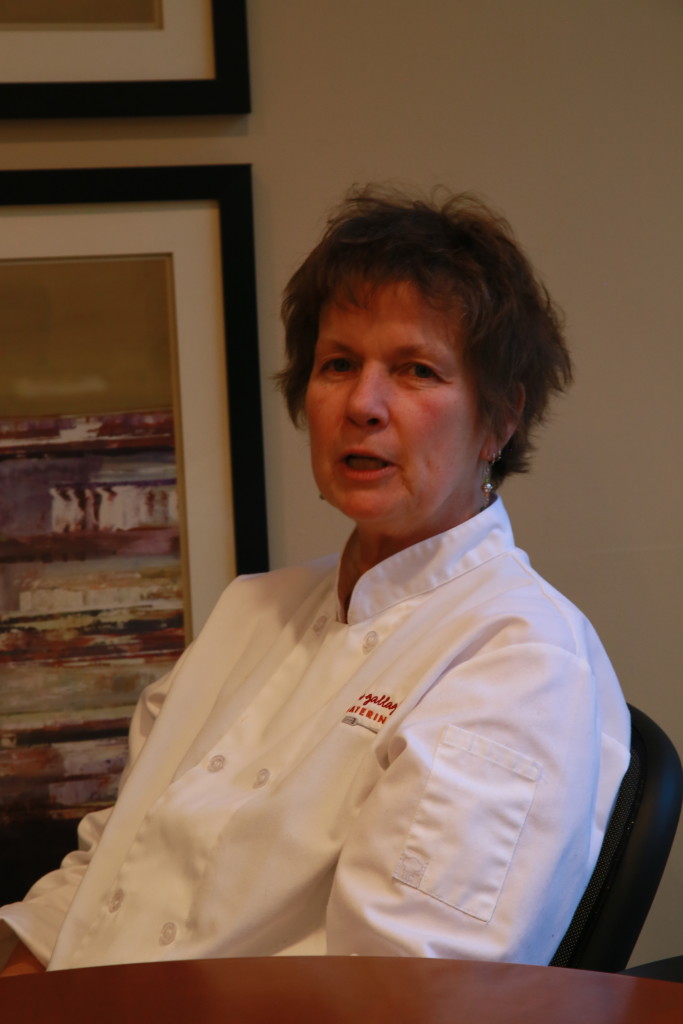Food For Thought
A new program at the Connecticut Mental Health Center changes lives for at-risk patients

“First question — who’s hungry?”
This is Anne Gallagher’s opening line as she addresses the small group huddled before her around a kitchen table. Clad in a white chef’s coat embroidered with her name, Chef Anne — as she is called by everyone — is a professionally trained chef who owns a successful farm-to-table catering company.
But today, she won’t be making hors d’oeuvres. On the surface, she will be teaching the group a simple skill: how to cook a chicken. In reality, though, she has a much bigger goal in mind: teach her small audience how to eat healthy despite struggling with mental illness and living on less than $6 for food per day. For the group of outpatients gathered before her in the fifth floor kitchen of the Connecticut Mental Health Center, food — and health — can never be taken for granted.
The Connecticut Mental Health Center is a community mental health center co-run by the state of Connecticut and Yale with the mission of providing mental health care to low-income and underserved populations. Its five-story building, with enough beds for only 42 inpatients, sits in the shadow of the much larger Yale-New Haven Hospital right across the street. Still, CMHC serves around 6000 outpatients each year, and often up to 2400 outpatients at any given time.
“These patients are the poorest of the poor and sickest of the sick,” says Marydale Debor, who runs a firm called Fresh Advantage that began working with CMHC in 2011 to design and implement a new set of food policies. “We’re looking at an institution that’s serving people that are really deprived.”
A part-time chef, part-time educator, Chef Anne is just one member of a team that runs the “Better Eaters Club” at CMHC. Every Tuesday afternoon, the group of outpatients and peer facilitators — alumni of the program who return to help — meets in CMHC’s small fifth-floor kitchen, well-lit by the large windows lining the wall and lending a view of the hospital across the street. There, they learn how to shop for, cook and eat healthy food on a budget.
Better Eaters Club is just one branch of a larger effort at CMHC to change the way that patients and staff approach food. The changes are everywhere, from the cafeteria to the staff lounge to outpatient programming, all envisioned by Debor and implemented by Bob Cole, chief operating officer of CMHC.
“The Better Eaters Club,” Debor says, “is part of a whole constellation of changes.”
—
As an institution that serves both inpatients and outpatients, food is present in CMHC through two main channels: the cafeteria, where outpatients and staff eat, and in-room food service for inpatients.
Before this year, food was not prepared on site — it came from the YNHH cafeteria and was transported to CMHC through an underground tunnel. There were also numerous vending machines throughout the clinic that sold sugar-sweetened beverages. As a result, Cole says, patients at CMHC were developing medical issues on top of their psychiatric issues.
According to Cole, the first seeds of change were planted at the top of the hospital’s administrative ladder — an unusual place for this type of reform to start. Shortly after Michael Sernyak, professor of psychiatry at Yale and CEO of CMHC, assumed his position at the helm, he expressed concern with the food offered at the institution. Sernyak cited the Hippocratic Oath, the promise that doctors make when they take up their profession.
“We say we’ll do no harm, but the food was harming them,” Cole says. “[Sernyak] turned to me and said, ‘We need to do better.’”
Once Sernyak planted the idea, Cole began looking for potential partners, and his search soon led him to Debor, who had carried out a very similar project at New Milford Hospital.
Her first piece of advice? Develop an institutional food policy. Small changes with big impact would be a quick win, she said, and a good way to start changing people’s mindsets while logistically larger changes were still underway.
They started by removing all the vending machines — all but one, that is. But one vending machine in a building of 500 employees is still a win, Debor says. She insisted that effecting change could not be accomplished by “just taking things away,” so in place of the vending machines, CMHC installed new filtered-water dispensers.
Meanwhile, larger projects were being put in motion. The priorities were inpatient food and the cafeteria. Weaning the institution off of YNHH’s food services would require the construction of a commercial kitchen in CMHC. The pre-existing cafeteria was gutted, and this past July, the cafeteria project was finally finished, with state-of-the-art equipment and the hiring of a new vendor for the cafeteria so the food could be made on-site from scratch.
Looking around CMHC, the institutional changes appear in unexpected places. A formerly empty courtyard is now a garden, where Jacqueline Maisonpierre, farm manager at New Haven Farms, visits once a week to care for the plants and work with inpatients. The plant options are restricted by the limited access to water and sunlight in the garden, Maisonpierre says, but they are currently focusing on growing herbs. For many inpatients, visiting the courtyard garden is their only chance to enjoy fresh air and sunlight.
“Patients have showed a lot of response to the garden,” Maisonpierre says. “They come down morose, but by the end you definitely see a light in their eyes.”
The programs extend to outpatients too, with morning walking groups, a farmer’s market in the parking lot and more personalized services like Better Eaters Club. Clinical nutritionist Francine Blinten holds individual nutritional consultations with patients, and Annie Harper, research scientist in psychiatry, does financial health consultations. Debor likes to refer to this model as the “hub and spoke” model, with CMHC as the hub and the programs as the spokes reaching out to clients.
“We create a healthy food hub in the hospital, and then we create programs that can be supported by that operation,” she says. “This approach has been profoundly successful and transformational.”
—
Conversations about food are everywhere at CMHC. Even in the elevator on the way up to Better Eaters Club, Bob — a peer facilitator — gets into a conversation with a patient about drinking soda. The patient proudly states that she now only drinks soda on special days, like birthdays and holidays.
“Now, you know soda’s no good,” Bob says, launching into a mini lesson on the health benefits of water.
Bob took the two-part Better Eaters Club sequence earlier this year, and now he’s back to serve as peer support, making sure participants feel comfortable.He first came to CMHC as an inpatient himself, staying in the hospital for three weeks. He says while battling his mental illness, he gained almost 40 pounds, which he now attributes to a combination of his depression and his medications.
Bob says he knew his eating habits were unhealthy. He used to eat out often, and his meals often included lots of red meat. After taking Better Eaters Club, though, he sees a distinct difference in his attitude about food. He now cooks for himself and his girlfriend. He eats more vegetables. And since beginning consultations with Blinten, he has lost 20 pounds.
“[Better Eaters Club] is my favorite,” he says with a wide grin. “I would stay here forever.”
For today’s Better Eaters Club, the room is abuzz with anticipation about the main attraction: the chicken. But before the students begin making the meal, they must first familiarize themselves with their tools. Chef Anne sets a cast-iron pan upon the table and invites everyone to feel its rough oil-encrusted surface. She encourages everyone to invest in one, lauding its versatility.
Chef Anne then pulls out the second key ingredient for today’s lesson: a pot of vegetable scraps. She has been saving these scraps at the end of each lesson for the past few weeks, she says, and today they will use them to make a vegetable broth.
These are the kinds of practical skills that the team seeks to teach clients — ways to make the most of their limited resources.
“We want to make sure the food we cook and the conversations we have are realistic to people,” Harper said. “What we’re trying to teach needs to be possible in people’s lives.”
The students move to the prep table and assume their positions. Serena cuts the parsnips, Doris chops the greens and Bob cuts the jalapeños. Chef Anne keeps a careful eye on them, complimenting their knife skills and giving them suggestions on their technique.
Being able to use a knife is one of many skills that is not to be taken for granted here — many individuals suffering from a mental illness are uncoordinated or unsteady, and psychiatric medications often cause shaking as a side effect, Blinten says.
In some cases, this might mean teaching participants how to adapt to their limits: for example, Blinten recalls one patient who was hesitant about using sweet potatoes in her cooking because of the coordination required to peel them. Instead, she encouraged the patient to think of other ways to prepare the vegetable, like cutting it without peeling it.
Back in the kitchen, Chef Anne is ready to season the chicken. “What should I use?” she asks the room.
“Salt.” “Pepper.” “Rosemary.” A chorus of suggestions rings out. Chef Anne beams.
Self-sufficiency and ownership are two skills that the class strives to teach. Each participant receives a copy of Good and Cheap, a cookbook designed to provide healthy meals that cost under $4 a day. The participants are encouraged to use these recipes as guidelines, but to personalize them as needed for their personal health, financial situations and individual tastes.
“We tell them to mark up the book, rip out pages and grade recipes,” Blinten says. “There’s so much empowerment in owning it and making it your own.”
Blinten recalls one Better Eaters Club participant who came to CMHC because of her schizophrenia. During the first few classes, Blinten says, she was afraid to use a knife and often appeared unengaged.
One day during class, though, Blinten says the woman suddenly looked up and said,“I don’t hear my voices when I’m in Better Eaters Club.”
“She became an actor in her own fate,” Blinten explains.
—
One week later, the group gathers again, but not in the warm kitchen. This time, they are huddled outside, waiting for a dark blue van. Today is the long awaited shopping trip, a highlight of the six-week-long program.
CMHC Director of Social and Vocational Rehab Services Ann Joy pulls up with the van, and everyone piles in. It’s like a road trip, and Chef Anne is prepared with supplies. She pulls out a box of all-natural energy bars.
“Is anyone hungry?” she asks. “Never go shopping hungry.”
Today’s trip will include two destinations: Stop and Shop and Edge of the Woods Market. The goal for the day is to teach participants how to shop for healthy food on a budget.
As the group walks through the produce section of Stop and Shop, Chef Anne points out which vegetables are less expensive and in season. They learn that the gravity bins at Edge of the Woods are a good way to buy smaller quantities of nuts if the full packages of nuts are too expensive.
For many clients, buying healthy food seems impossible since their food budget is often limited to $6 per day, Blinten says. A large number of CMHC clients are reliant on government benefits, such as social security, unemployment and food stamps, which are distributed early in the month. However, it is often difficult for them to make this small sum of money stretch throughout the month, she adds, since the patients are often very focused on the present, rather than the future.
Outside CMHC, Blinten runs a private practice in Greenwich. After working with clients there, who have sufficient resources to shop at Whole Foods, Blinten comes to CMHC, where clients struggle to buy food for the second half of the month as they wait for the next month’s social security and unemployment benefits.

Francine Blinten contributes an individual piece to the program— nutritional consultations with patients.
“[CMHC clients and Greenwich clients] are really more similar than different,” Blinten says. “Clients at CMHC are just as motivated, but they have to wait for their benefits, and they’re often struggling with a lack of resources. They’re more resilient.”
—
When class ends and participants file out, Serena hangs back to help clean up. Serena is a peer facilitator who went through Better Eaters Club earlier this year, but she has loved food long before her first day in the CMHC kitchen. In 1990, she says proudly, she made a new year’s resolution to become a vegan. Back then, she was involved with community gardening and was part of the team that set up the one of the city’s first cooperative gardens and the first farmer’s market.
However, in 1996, she came to CMHC as an inpatient, and her dreams had to be put on hold, as she figured out the right balance of medications.
Now, almost 20 years later, armed with a scholarship and savings, Serena is going back to school to be a nutrition educator. But not just any school — she will be attending Chef Anne’s alma mater, the Natural Gourmet Institute for Health & Culinary Arts.
“It’s all going to come together,” she says excitedly. “I’m going to be where I want to be.”
Serena is just one of many success stories that have come out of the program, but success takes a different shape for other patients, Harper says. For some, it means they are able to meet their weight-loss goal. For others, it might just mean being able to chop vegetables to make a healthy meal.
The program is still in its pilot phase and has yet to be made a permanent fixture, Cole says. But most of the team members say they believe the program is here to stay. Chef Anne says she hopes the program will become an integral part of wellness for people who are mentally ill.
After all, she added, “Food is very powerful.”









